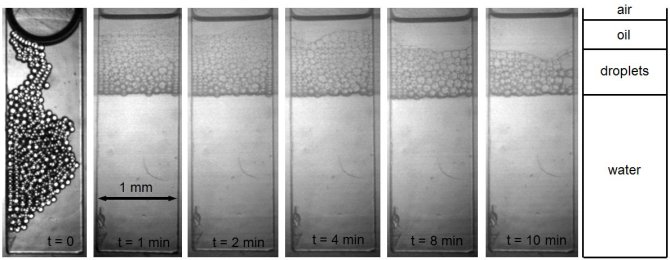Project
Dynamics of Emulsion Coalescence
The stability of emulsions is an important factor for various industrial branches, such as the food, pharmaceutical and petroleum industries. For animproved prediction and control of emulsion stability it is necessary to understand the mechanism of droplet coalescence on a microscopic level. We use microfluidic methods to study the dynamics of coalescence in dense flowing or compressed emulsions, as these are often encountered in industrial applications.
The movie below displays a microfluidic channel (width 0.5 mm) where an emulsion of monodisperse oil droplets in water is flowing from the left toright. In the channel, droplets collide and coalesce, which increases the mean diameter of the droplets in the emulsion. The movie is slowed down from 10000 to 25 frames per second, the average droplet velocity is 0.2 m/s.
A series of images displaying a coalescence event between two oil droplets dispersed in water is shown below. The thin liquid film between the dropletsruptures when the droplets are close enough to each other, and the coalesced droplet then quickly relaxes to a spherical shape.

With the microfluidic setup, we can directly measure the coalescence rate in emulsions as a function of the relevant system parameters, such as dropletsize, oil viscosity, oil volume fraction, shear rate and chemical additives like surfactant and salts.
Another experimental setup permits to measure the rate of emulsion breakage under enhanced gravity. Emulsions are often subjected to centrifugation inindustry to separate the oil and water phases, such as in the skimming of milk. The figure below displays snapshots of an emulsion that is centrifuged at an enhanced gravity of ~ 1000x the normal gravitational acceleration. A pure oil layer forms upon centrifugation, which grows with time due to coalescence of drops with the pure oil phase. The mean droplet size in the dense compressed droplet layer also increases. From the experiments, characteristic times for coalescence of a droplet with the pure oil phase and for coalescence between droplets in the compressed emulsion layer can be derived.

T. Krebs, J.J. Slot, C.G.P.H Schroen, H.W.M. Hoeijmakers, R.M. Boom,
Emulsion compression and coalescence under enhanced gravity studied with
in-situ microscopy, Proceedings of the 9th International Conference on
Advances in Fluid Mechanics, 2012, Split, Croatia
T. Krebs, C.G.P.H Schroen, R.M. Boom, A microfluidic study of oil-water
separation, Proceedings of the 6th International Conference on Computational
and Experimental Methods in Multiphase Flow, Kos, Greece, 2011
T. Krebs, C.G.P.H Schroen, R.M. Boom, Coalescence kinetics of
surfactant-stabilized emulsions studied with microfluidics, Soft Matter,
2012, DOI: 10.1039/C2SM26122G
T. Krebs, C.G.P.H. Schroen, R.M. Boom, Separation kinetics of an
oil-in-water emulsion under enhanced gravity, Chemical Engineering Science,
71, 118-125, 2012
T. Krebs, C.G.P.H. Schroen, R.M. Boom, A microfluidic method to study
demulsification kinetics, Lab on A Chip, 12, 1060-1070, 2012
T. Krebs, C.G.P.H Schroen, R.M. Boom, Microfluidic methods to assess
demulsification kinetics for oil - water- separation, 23rd Oil Field
Chemistry Symposium, 2012, Geilo, Norway
T. Krebs, C.G.P.H Schroen, R.M. Boom, A microfluidic study of oil-water
separation, 6th International Conference on Computational and Experimental
Methods in Multiphase Flow, Kos, Greece, 2011
